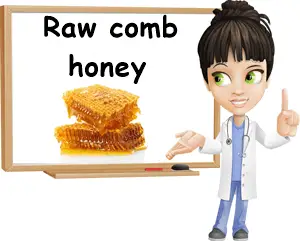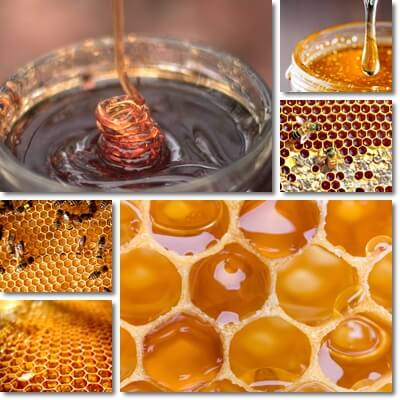Comb honey is honey still in its original frame: the honeycomb. It is raw honey, removed from the beehive as it is which makes it the most natural form of honey you can possibly get. The entire honeycomb is edible, both the beeswax shaping the comb and the liquid honey enclosed in the beeswax cells. Honeycomb honey is the best guarantee you can have that the honey you are eating is in its most natural, least processed form. A word of caution though: natural doesn’t equal organic, unless it says so. For it to be organic, the honey would have to have been made from flower nectar sourced from uncontaminated areas, far away from industrial production and modern human civilization.
What is a honeycomb?
A honeycomb is the natural structure that honeybees build to deposit their honey and grow their offspring. It is edible, just like the honey and other honeybee by-products such as propolis, royal jelly and bee bread (even bee brood). A honeycomb is actually made of wax, or beeswax (cera alba). Beeswax is produced by honeybees themselves, secreted from special glands located on their abdomen. The beeswax is molded to form hexagonal chambers called wax cells, where honey is deposited and honeybee eggs are laid, and larvae and pupae are raised. The wax chambers or cells are also capped by honeybees with wax which protects the honey from spoilage.

What does a honeycomb look like?
A honeycomb is the original frame used for depositing honey. If left on their own, honeybees will produce combs of various shapes and sizes, depending on available space, colony size, food availability and other factors. There is one constant though: the hexagonal structure of the wax cells. However, beekeepers often provide their honeybees with a foundation: a wax comb base of a set-size and usually rectangular shape on which the bees can build the hexagonal wax cells where they deposit honey. This is why most comb honey available for sale is almost perfectly rectangular.
Honeybees are perfectly capable of building a comb from scratch by themselves, which is preferable and ensure you buy a more natural product. But for aesthetic purposes, they are given wax foundations for their combs (usually embedded in wooden frames and held with wires). Some beekeepers will use wood or plastic too, especially if they don’t offer comb honey for sale.
What does comb honey look like?
Comb honey is liquid honey deposited in a comb or honeycomb made by honeybees from beeswax. More exactly, the honey is deposited into hexagonal wax cells and capped with wax. You can call it comb honey or honeycomb honey or just honeycomb.
Different varieties of honey will result in different comb colors. For example, black locust or false acacia honey is very light-colored, which means the comb honey will also be light colored. Whereas buckwheat honey is dark colored (a copper and reddish-brown color to a dark reddish brown, almost black color), meaning the comb will also look darker. Also, wax cells where young bees are raised tend to be darker in color.
Can you eat honeycomb wax?
Yes, you can eat honeycomb wax. Both the comb structure itself, which is made from beeswax, and the liquid honey it contains are perfectly edible and sources of nutrition and health benefits. Both the honeycomb itself and the comb honey are raw and unprocessed (comb honey or honeycomb honey is the name for honey contained in the comb). When you buy honeycomb honey or comb honey, you are getting a guarantee of raw, unprocessed bee products.
How to eat honeycomb
What baffles many people is how to eat honeycomb. Do you just eat the honey in the comb or the comb too? Do you extract the honey from the comb first? Do you heat the comb? How do you eat it? The answer is: you break a piece of the comb with your hands or cut it and eat it. You can eat it by itself as a sweet snack or put it on bread or add it to something else that would taste good to you. Ideally you should eat comb honey raw – heating or cooking with it will take away from its beneficial properties. I mean, why get raw honey if you’re not going to eat it raw?

Difference between comb and chunk honey
The biggest difference between comb and chunk honey is size. Comb honey is the entire comb, whatever size it may be (usually large). The honey is usually sealed in the wax cells, but not all wax cells are sealed.
Chunk honey is just chunks of comb, usually available immersed in a jar of liquid honey. In my opinion, comb honey is better than chunk. Comb honey is removed from the hive as it is and doesn’t undergo any processing, so it’s raw: unfiltered, unheated and unadulterated. Whilst chunk honey may be immersed in processed honey. Prices also vary: while chunk honey is definitely more expensive than liquid, comb is even more expensive than chunk.
The main factor determining the higher price of comb is the reduced availability.
Where can you buy honeycomb?
Online, at the farmer’s market, at health food stores, at your local supermarket sometimes or directly from beekeepers. Not all beekeepers have raw honeycomb for sale – for example, for reasons that have to do with trimming expenses, beekeepers will extract the honey from honeycombs and place the combs back in the hives to reuse. Also, some will use combs made from wood, plastic or other materials which are not edible. But if you’re looking to buy, do ask your local beekeeper.
Comb honey properties
- Comb is honey in its most natural form.
- It is raw, unfiltered, unheated, unadulterated, utterly unprocessed.
- The beeswax shaping the comb is edible and provides additional nutrition.
- The beeswax is a source of wax, propolis, antibacterial bee enzymes etc.
- The entire comb is a source of health benefits.
- The wax-sealed combs provide protection against spoilage.
- Comb honey tastes good. At body temperature, the comb is soft and chewy. But when cold, it’s dry and brittle.
- The beeswax is yellow and compliments the color of honey beautifully. It’s a great-looking edible to gift, as well as healthy.
What are the benefits of honeycomb honey?
How good is honeycomb for you? Just as good as raw honey. Maybe even better thanks to the presence of beeswax which adds to the health-promoting properties of the honey. The comb itself both adds to the content of propolis, pollen, antibacterial enzymes and more, and guarantees a higher content of these healthful compounds in the honey itself (being sealed in the cells with wax, honey is neither strained, nor filtered which would cause the removal of a great deal of pollen, propolis and other particles). Here is a list of potential benefits:
- Soothes sore throat irritation and pain by creating a film over the throat lining – best eaten at room temperature so the comb is not dry and brittle, but soft and chewy.
- Has demulcent properties and helps calm cough as well as reduce throat irritation and discomfort.
- Soothes heartburn caused by acid reflux by creating a film over the throat lining to calm irritation and inflammation caused by regurgitation of highly acidic stomach juices.
- Helps soothe digestive discomfort caused by gastritis and peptic ulcers.
- Has antibacterial and antiseptic properties that may help heal small wounds faster and reduce pain associated with them (insect bites, small cuts, scratches, burns, eczema, irritation).
- Eating comb honey is good for upper tract respiratory infections – both the raw honey and comb are sources of propolis and pollen with immuno-modulating properties, while the honey has an acidic pH which prevents microbial growth, a low water and high sugar content which makes it dense and viscous and allows it to create a film over mucous membranes, inhibiting microbial growth as well, and contains antibacterial elements such as hydrogen peroxide and methylglyoxal.
- Being raw and a source of natural enzymes and various particles, it provides probiotic properties.
- Combats hypoglycemia by raising blood sugar levels.
- Has antiviral, antifungal and antioxidant properties.
- Holds benefits for skin, calming irritation, reducing swelling and redness, evening out uneven skin tone and provides gentle exfoliation and antibacterial and hydrating benefits.
